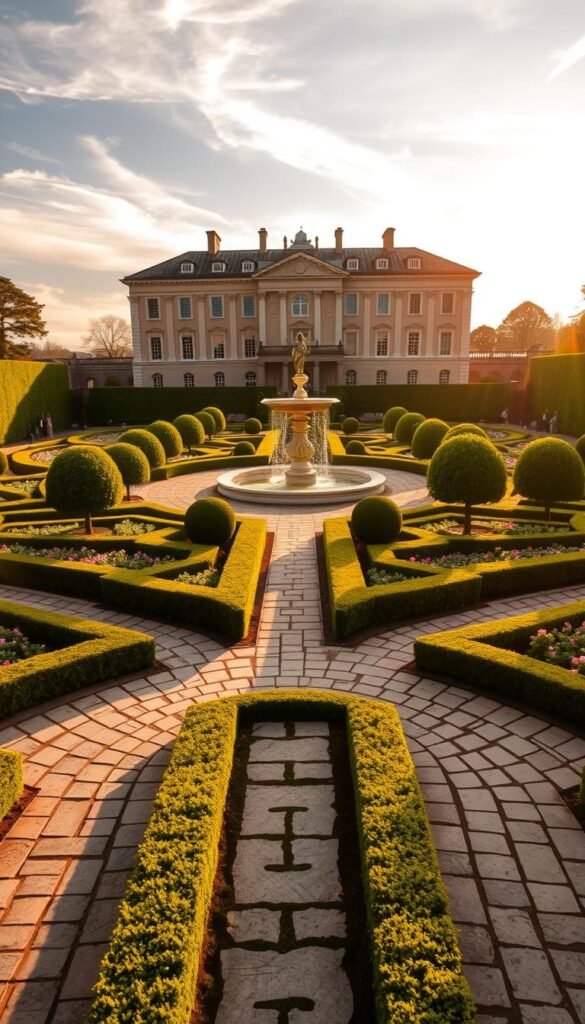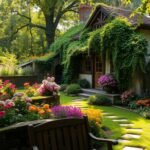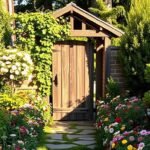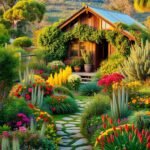Imagine stepping into an outdoor space where every hedge aligns perfectly and pathways mirror each other like reflections. This is the essence of a timeless gardening approach that blends human creativity with nature’s beauty. Rooted in ancient traditions, these spaces have evolved over centuries, offering a structured yet serene escape right in your backyard.
Originally inspired by walled gardens in Western Asia, this artistic method gained prominence through Persian landscapes and European Renaissance estates. Its core lies in balance—geometric shapes, crisp edges, and deliberate plant placements create harmony. While it demands careful upkeep, the result is a living masterpiece that feels both grand and intimate.
You’ll notice how every detail matters here. From symmetrical flower beds to precisely trimmed shrubs, the focus on order transforms ordinary yards into elegant retreats. Though maintaining this look requires effort, many find the calming atmosphere and visual impact worth the work.
Whether you’re drawn to historical influences or crave a polished outdoor sanctuary, this style offers endless inspiration. It’s not just about plants and paths—it’s about crafting a space where nature and design dance in perfect rhythm.
Laying the Groundwork: Mapping Your Garden for Perfect Symmetry
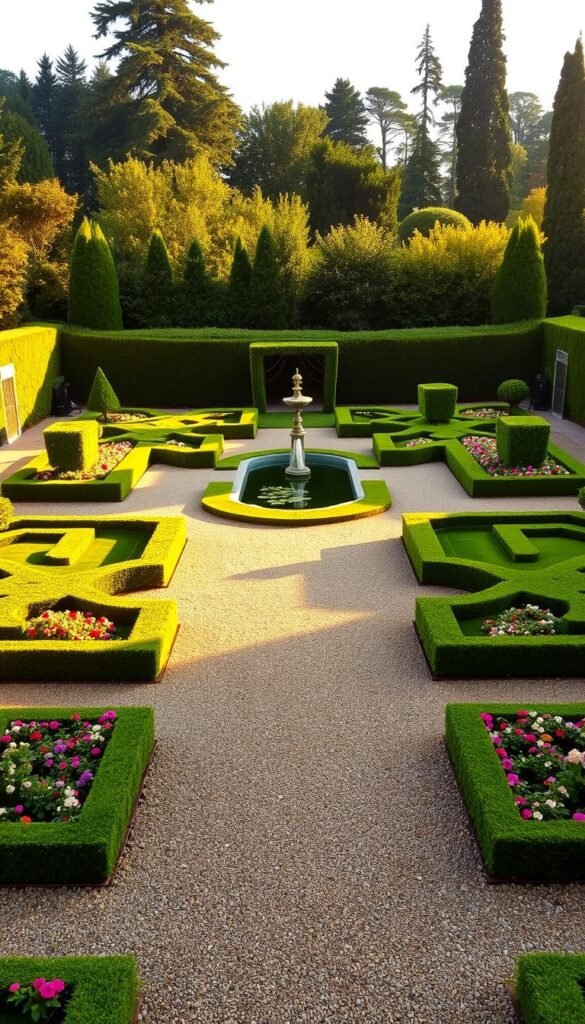
Every great outdoor masterpiece starts with a blueprint. Before planting a single shrub, you’ll need to measure your area thoroughly. Grab graph paper or use digital tools to sketch your property’s dimensions from above—this bird’s-eye view reveals patterns that ground-level planning might miss.
Assessing and Measuring Your Space
Start by marking permanent features like trees or slopes. Use stakes and string to outline potential pathways or flower beds. Did you know many historic estates planned their structured outdoor areas to impress guests viewing them from balconies? This approach ensures your layout looks intentional from every angle.
Translating Your Vision into a Detailed Plan
Once measurements are precise, layer in geometric shapes—circles for fountains, rectangles for hedges. Balance is key: if you add a feature on one side, mirror it opposite. Tools like garden apps help visualize spacing between plants or seating areas.
Remember, a well-mapped space prevents overcrowding and maintains clean sightlines. Whether working with a sprawling yard or cozy patio, this method turns chaotic plots into harmonious retreats. Your future self will thank you for avoiding those “I wish I’d measured twice” moments!
Creating a Captivating Focal Point for Your Garden
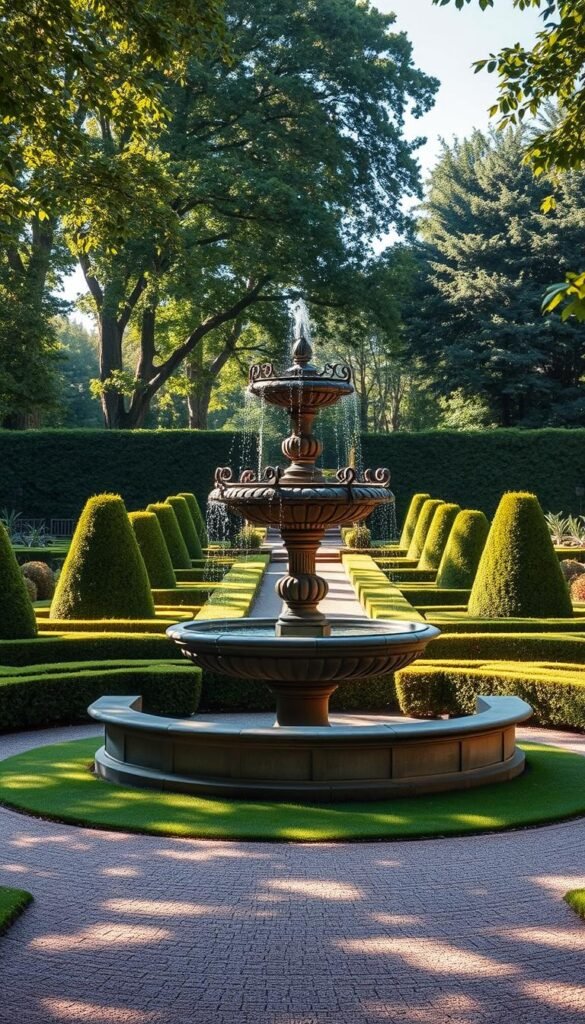
What makes a structured outdoor area unforgettable? A bold centerpiece that commands attention. This anchor becomes the heart of your layout, guiding visitors’ gazes and creating instant visual hierarchy. Think of it as the exclamation point in your landscape’s story.
Choosing the Right Centerpiece
Classic water features like tiered fountains never go out of style. For modern flair, try geometric sculptures or arched trellises. Size matters—a massive urn might dwarf a cozy patio, while petite birdbaths disappear in sprawling yards.
“Your focal feature should feel intentional, not accidental,” suggests landscape architect Maria Cortez. Balance grandeur with practicality. A sun dial adds whimsy, while stone benches double as seating.
Layering Elements for Maximum Impact
Frame your centerpiece with low boxwood hedges or radiating gravel patterns. Add depth with staggered plantings—tall topiaries behind, colorful annuals in front. This tiered approach makes your main attraction pop.
Pathways leading to the focal point create natural flow. Use symmetrical lighting to highlight it at night. Seasonal touches like autumn mums or winter evergreens keep the area dynamic year-round.
Remember, less is more. One showstopper with thoughtful accents beats cluttered competing features. Your eyes—and guests—will thank you.
Stately Hedges and Intriguing Topiaries
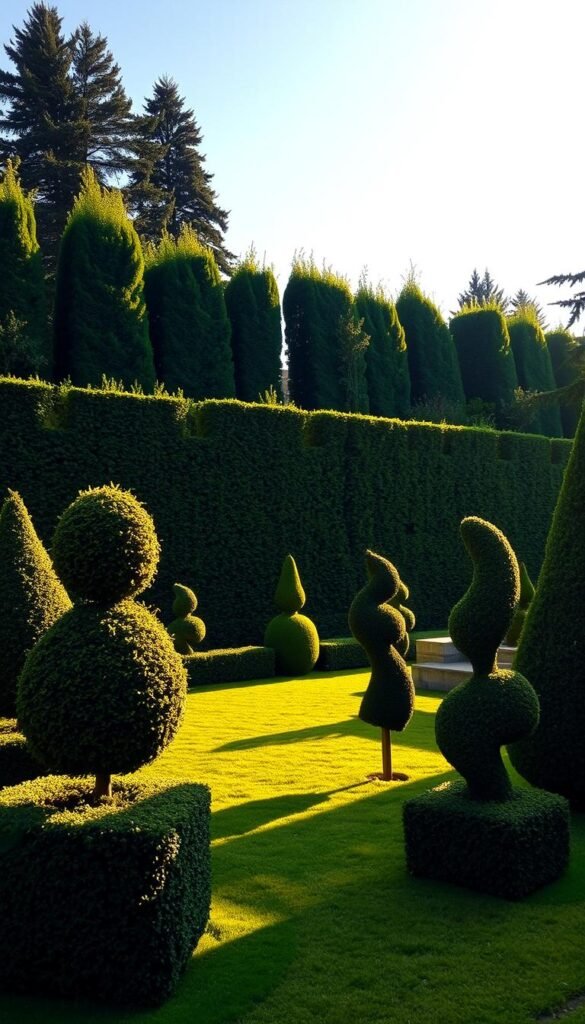
The true magic of a structured landscape lies in its living architecture. Manicured shrubs act as nature’s rulers, carving crisp boundaries while directing attention to focal points. These green walls bring rhythm to your outdoor space, blending practicality with artistry.
Selecting the Ideal Shrubs and Boxwoods
Boxwood remains the MVP for structured layouts, thanks to its dense foliage and sculptural flexibility. For variety, consider evergreen shrubs like arborvitae—their columnar forms add vertical drama. Viburnum offers textured leaves, while ligustrum grows quickly for impatient gardeners.
Tips for Sculpting Imaginative Topiaries
Start simple: spheres and cones teach you shaping fundamentals. Once confident, try spirals or animal forms using wire guides. Dense plants like yew work best—they hide pruning mistakes and recover fast.
Remember, topiaries thrive with monthly trims during growing seasons. Keep shears sharp to avoid bruising leaves, and always cut slightly above growth nodes. Pair taller sculptures with low hedges to create depth without clutter.
Your garden gains personality through these green sculptures. Whether you prefer geometric precision or playful shapes, they’ll maintain clean lines that elevate your entire space. Just don’t forget the gloves—those tiny leaves love hiding in pockets!
Defining Your Garden with Well-Designed Walking Paths
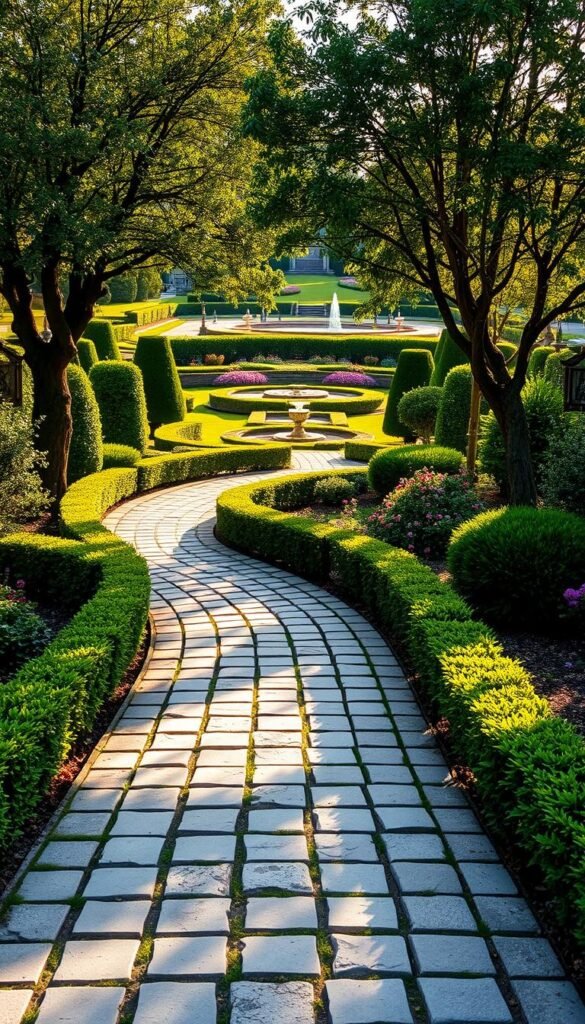
Paths act as the backbone of your outdoor layout, guiding movement while protecting delicate blooms. Like veins in a leaf, they connect key garden areas while maintaining crisp boundaries. Choosing the right materials and patterns transforms functional walkways into design statements.
Considering Materials: Brick, Pavers, and Stepping Stones
Brick delivers old-world charm but demands precise installation. For quicker results, concrete pavers mimic historic styles with modern durability. Stepping stones offer playful flexibility—space them evenly for rhythm or cluster them for artistic flair.
Gravel serves as a budget-friendly base that crunches satisfyingly underfoot. Pair it with stone edging to prevent spreading. Avoid grassy paths—they blur lines and require constant trimming.
Ensuring Traffic Flow and Practicality
Map primary routes between entry points and seating areas first. Wider paths (36-48 inches) allow two people to stroll comfortably. Use gentle curves near focal points but keep turns purposeful—no meandering detours.
“Always build walkways before planting,” advises landscaper Tyler Nguyen. “You’ll avoid trampled perennials and ensure proper proportions.” Add solar lights along edges for nighttime safety and drama.
Choosing Evergreens for Year-Round Appeal

What keeps your outdoor space vibrant when other plants fade? The answer lies in versatile evergreens that anchor your landscape through every season. These resilient plants maintain their foliage while adding structure and depth to your layout.
Evergreens That Shine in Every Season
Holly bushes steal the winter spotlight with glossy leaves and ruby-red berries. Daphne surprises with fragrant pink flowers in late winter, while camellias bloom boldly when most trees stand bare. These choices prove evergreens aren’t just background players—they’re seasonal stars.
Mix textures for visual intrigue: pair spiky junipers with soft boxwoods. Taller varieties like Italian cypress create living columns, while compact shrubs form neat borders. Landscape designer Elena Rodriguez notes: “Layered evergreens act as nature’s scaffolding—they hold your garden together visually, even in February’s gloom.”
Strategically place these plants to shelter delicate perennials from wind. Their dense foliage also muffles street noise, making your space feel secluded. As spring arrives, watch how their deep greens make tulips and daffodils pop with color.
Remember—evergreens work harder than any other trees or shrubs. They provide privacy, reduce soil erosion, and host backyard birds. Choose varieties that thrive in your climate, and you’ll enjoy their quiet majesty for decades.
Designing a Parterre: Elegant Symmetry Near Your Home
Picture this: a living tapestry unfolds just beyond your back door, its crisp patterns visible through every window. That’s the power of a parterre—a French-inspired masterpiece that turns your yard into an art gallery. Built on flat terrain, these intricate layouts use low hedges and flower beds to craft geometric wonders best admired from above.
Start by mapping patterns that complement your home’s architecture. Simple squares or diamonds work well for beginners, while interlocking swirls add drama. Use boxwood or lavender hedges to outline shapes, filling inner spaces with colorful annuals or crushed stone. Remember, the true magic happens when viewed from your second-floor windows—design with elevation in mind.
These layouts act as bridges between indoor comfort and outdoor beauty. “A well-executed parterre feels like an extension of your living room,” notes landscape historian Claire Dubois. Keep pathways narrow to preserve sightlines, and consider adding elevated planters for vertical interest.
While Versailles’ grand examples might seem intimidating, you can scale down the concept. Focus on repeating motifs that match your property’s size—even a 10×10 foot area can host a stunning pattern. Maintenance matters: choose slow-growing shrubs to minimize trimming, and edge beds sharply to maintain definition.
Your parterre becomes a year-round showstopper. In winter, snow dusts the hedges like powdered sugar. Come spring, tulips erupt within the green frames. It’s not just a garden feature—it’s a daily masterpiece that greets you with every glance outdoors.
Add a Fountain for Timeless Elegance and Sensory Delight
Nothing transforms a structured landscape like the gentle murmur of flowing water. A fountain becomes more than decoration—it’s a living sculpture that elevates your outdoor experience through sight, sound, and motion. Whether grand or compact, this feature adds instant sophistication while drawing eyes to key areas of your layout.
Fountain Placement as a Visual Anchor
Position your water feature where it commands attention without disrupting flow. Center-stage placements work well in geometric layouts, while corner installations soften sharp angles. For seating zones, place fountains within view but slightly offset—close enough to enjoy, far enough to avoid splashes.
Creating a Soothing Auditory Experience
The trickle of water masks traffic noise and creates calm. Multi-tier designs offer rhythmic sounds, while single-spout styles provide steady white noise. Pair with weather-resistant benches or mixing vintage and modern elements like stone urns beside sleek loungers for contrast.
Choose materials that age gracefully: weathered stone suits classic themes, while copper develops a patina over time. Keep scale in check—a towering fountain overwhelms small yards, but a basin surrounded by low hedges feels just right. Birds will visit, adding playful movement to your garden’s polished framework.

